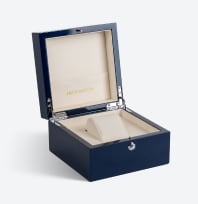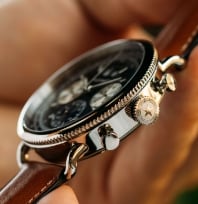Despite the constant evolution in technology, the wristwatch continues to be among the most coveted possessions. Whether as a status symbol, milestone purchase, or a symbolic gift or heirloom, the significance of watch is as historically significant as the personal experience. Historically, the introduction of the Pilot’s watch charts the impact of the wristwatch on both the aviation industry and mainstream menswear.
The introduction of the men’s pilot watch was ultimately a product of a friendship between Brazilian Pilot Alberto Santos-Dumont and Louis Cartier. As Santos-Dumont’s career in aviation began to expand, he complained of the trouble of balancing the need to check his pocket watch (yes, we said it…his pocket watch) mid-flight. As a reaction to his friend’s complaints, Cartier introduced Santos. With an easy to read dial and numerical markings, Santos-Dumont became the first man to replace his pocket watch for a wristwatch–until then only women had exclusively adorned the wristwatch.
As the celebrity of Santos grew and his designs more technical, so did the concept of men’s wristwatches. After the introduction of the Cartier Santos and World War I, the aviation industry became more mechanical, increasing the demand for the chronograph and other Aviation models.
Despite the demand for more functionality and evolution of the aviation-inspired timepiece, even over a century later, the historically bold watch is recognizable across brands and models. And primarily due to the first model by Cartier himself, which remains both functional and luxurious.

The historical significance, bold features, and iconic place in both American and timepiece history have made the aviation-style watches as recognizable now as in its original form. So when it came down to choosing the inspiration for the launch of the Jack Mason watch line in 2015, the Aviation Collection seemed like a no brainer. At the opportunity to launch the first-ever collection for the brand, Jack Mason’s Creative Director Peter Cho wanted to not only design something he would wear today. As a lifelong watch enthusiast and veteran watch designer, Cho also wanted to tip his hat to the historical significance of the watch in its purest form. “I wanted to pay homage to something both classic and iconic with our first collection–something that would represent our direction for the brand,” said Cho.
As we introduce our newest collection of Jack Mason aviation watches, we take a look at some of the features that make Pilot watches and our aviation collection specifically.
The post The History of the Aviator appeared first on Jack Mason.









